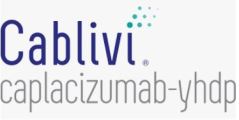Drug Authorizations: SPRAVATO for treatment-resistant depression, CABLIVI for thrombotic thrombocytopenic purpura, EGATEN for fascioliasis
SPRAVATO™ (esketamine) nasal spray, CIII
Janssen Pharmaceuticals, Inc.
INDICATION: In conjunction with an oral antidepressant, for the treatment of treatment-resistant depression (TRD) in adults
Limitations of Use: Not approved as an anesthetic agent
ADDRESSING UNMET NEED:
- Long-standing need for additional effective treatments for treatment-resistant depression, a serious and life-threatening condition
- FDA review of safety and efficacy along with robust discussion with external advisory committee
MECHANISM OF ACTION: Esketamine, the S-enantiomer of racemic ketamine, is a non-selective, noncompetitive antagonist of the N-methyl-D-aspartate (NMDA) receptor; mechanism of antidepressant effect is unknown
EFFICACY:
- Three short-term (four-week) clinical trials and one longer-term maintenance-of-effect trial; Spravato vs. placebo nasal spray – all patients on new oral antidepressant (AD) from time of randomization
- Primary endpoint: Change in baseline in Montgomery-Asberg Depression Rating Scale (MADRS) total score
- SPRAVATO plus AD demonstrated statistical superiority vs. placebo
- Timecourse: SPRAVATO’s treatment difference observed at 24 hrs; both arms continued to improve to Day 28.
- In the longer-term maintenance-of-effect trial: SPRAVATO + AD experienced a statistically significantly longer time to relapse of depressive symptoms vs, placebo
SAFETY:
- Boxed Warning: Risk for sedation and difficulty with attention, judgment and thinking (dissociation), abuse and misuse, and suicidal thoughts and behaviors after administration of the drug
- REMS with Patient Enrollment Form and patient Medication Guide; self-administration of nasal spray under supervision of health care provider in certified doctor’s office or clinic; spray cannot be taken home
- Most common side effects: Disassociation, dizziness, nausea, sedation, vertigo, decreased feeling or sensitivity (hypoesthesia), anxiety, lethargy, increased blood pressure, vomiting and feeling drunk.
REG PATHWAY: NDA
- The FDA approved ketamine (Ketalar) in 1970. This is the first FDA approval of esketamine for any use
- Fast Track and Breakthrough Therapy designations
- Postmarketing requirements: Long-term effects esketamine on cognitive function and urinary symptoms, further characterize potential risk of increasing thyroid stimulating hormone levels

CABLIVI (caplacizumab-yhdp)
INDICATION: Treatment of adult patients with acquired thrombotic thrombocytopenic purpura (aTTP), in combination with plasma exchange and immunosuppressive therapy
ADDRESSING UNMET NEED: Treatment option for a Rare disease
MECHANISM OF ACTION: Targets A1-domain of von Willebrand factor (vWF) and inhibits the interaction between vWF and platelets, thereby reducing both vWF-mediated platelet adhesion and platelet consumption
- Clinical study, n=145 patients with aTTP stratified per Glasgow Coma Scale score, CABLIVI vs placebo, median treatment duration of 35 days
- Endpoint: Time to platelet count response (platelet count ≥150,000/µL followed by cessation of daily plasma exchange within 5 days
- Time to platelet count response shorter with CABLIVI vs. placebo, lower number of TTP-related deaths (0 vs. 3) and TTP recurrence (3 vs. 28)
- Recurrence of TTP in overall study period lower with CABLIVI vs placebo (28/73 patients [38%]; p<0.001)
- Most common adverse reactions: Epistaxis, headache, and gingival bleeding.
REG.PATHWAY: BLA
- Priority review and orphan product designation
- Postapproval commitments on manufacturing and testing

EGATEN™ (triclabendazole) tablets, for oral use
Novartis
- WHO estimates ~ 2.4 million infected people infected in > 70 countries worldwide
- Treatment option for global markets
MECHANISM OF ACTION: Anthelmintic against Fasciola species
EFFICACY:
- Open label, randomized trial, in Vietnam, n=100 children, EGATEN vs. artesunate, 3 months treatment
- No clinical symptoms in 92% EGATEN vs in 76% placebo, p = 0.035
- Six nonrandomized, open label studies in Cuba, Bolivia, Peru, Chile, Iran, n=245 adult and pediatric patients with stool-confirmed fascioliasis
- Cure defined as absence of Fasciola eggs in stool based on Kato-Katz method. Day 60
- Dose response seen in all studies
SAFETY:
- Most common adverse reactions: Abdominal pain, hyperhidrosis, nausea, decreased appetite, headache, urticaria, diarrhea, vomiting, musculoskeletal chest pain, pruritus
REG PATHWAY: NDA
- Fast Track and Orphan Drug designations
- Tropical Disease Priority Review Voucher to encourage development of products for certain tropical diseases
- Postmarketing requirements: QT/QTc trial, additional dose evaluation,
